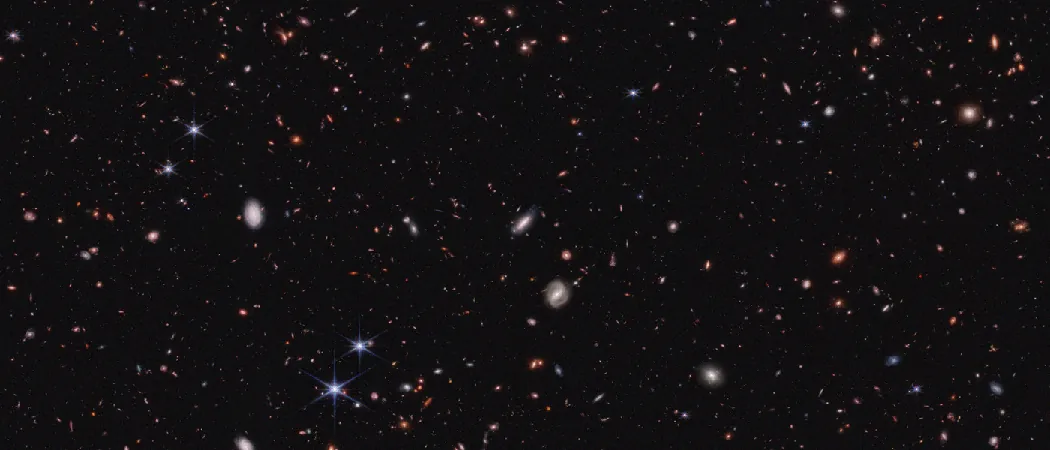
Astronomers’ Galaxy Formation Theory Faces a Groundbreaking Challenge!
2024-11-12
Author: Benjamin
In a stunning twist that could upend our understanding of the cosmos, recent findings from Case Western Reserve University have raised significant doubts about the prevailing theory of galaxy formation. The well-accepted paradigm, which has stood for decades, contends that dark matter played a crucial role in the emergence of galaxies in the early universe. However, new observations from the James Webb Space Telescope (JWST) reveal an unexpected reality that could reshape our very conception of the universe.
The standard model, known as Cold Dark Matter or lambda-CDM, expected JWST to detect faint signals from small, primitive galaxies, indicative of the gradual accumulation of cosmic matter. Instead, astronomers are discovering that the earliest galaxies are surprisingly large and luminous, contradicting the predictions and suggesting a rapid formation process.
Stacy McGaugh, an astrophysicist and professor at Case Western Reserve, led the research published in The Astrophysical Journal on November 12, asserting, “What the theory of dark matter predicted is not what we see.” McGaugh proposes an alternative explanation rooted in a theory known as MOND, or Modified Newtonian Dynamics, which posits that gravity itself may have functioned differently in the early universe.
According to MOND, the formation of galactic structures happened much faster than the traditional model suggests. While the lambda-CDM theory imagines a slow assembly of matter leading to larger galaxies, MOND envisions that mass coalesced quickly and initially expanded outward with the universe’s growth. Eventually, gravitational forces would slow this expansion and cause the mass to collapse into galaxies. This paradigm does away with the need for dark matter altogether, a notion that has puzzled many astronomers.
The JWST, launched in 2021, was designed to probe deep into cosmic history, aiming to unlock the mysteries of when and how stars and galaxies formed. McGaugh noted that while JWST results were anticipated to reveal the dim remnants of early galaxies, instead, the telescope is uncovering bright and massive structures continuing to shine brilliantly in epochs previously deemed too early for such growth.
These unexpected observations challenge the very foundation of the lambda-CDM model. As McGaugh elaborated, “Astronomers invented dark matter to explain how you get from a very smooth early universe to the substantial galaxies with vast voids we observe today.” The researchers involved, including Federico Lelli, Jay Franck, and James Schombert, echo the sentiment that these findings could herald a shift in the paradigm of astrophysics, providing a rare opportunity to reassess existing theories.
“It's a humbling moment,” McGaugh stated. “I was raised to think that saying ‘I told you so’ was rude, but that encapsulates the essence of scientific inquiry: we formulate predictions, and the universe shows us what's right.” As the scientific community grapples with these revelations, a major challenge lies ahead: uniting the principles of MOND with the established framework of General Relativity, a feat that could redefine the laws of physics as we know them.
With the universe throwing these curveballs, the question remains: how will astronomers adapt their theories to accommodate this new frontier of cosmic understanding? What other secrets lie within the cosmos, just waiting to be uncovered by the JWST and future explorations? Stay tuned as this captivating story continues to unfold!









 Brasil (PT)
Brasil (PT)
 Canada (EN)
Canada (EN)
 Chile (ES)
Chile (ES)
 España (ES)
España (ES)
 France (FR)
France (FR)
 Hong Kong (EN)
Hong Kong (EN)
 Italia (IT)
Italia (IT)
 日本 (JA)
日本 (JA)
 Magyarország (HU)
Magyarország (HU)
 Norge (NO)
Norge (NO)
 Polska (PL)
Polska (PL)
 Schweiz (DE)
Schweiz (DE)
 Singapore (EN)
Singapore (EN)
 Sverige (SV)
Sverige (SV)
 Suomi (FI)
Suomi (FI)
 Türkiye (TR)
Türkiye (TR)